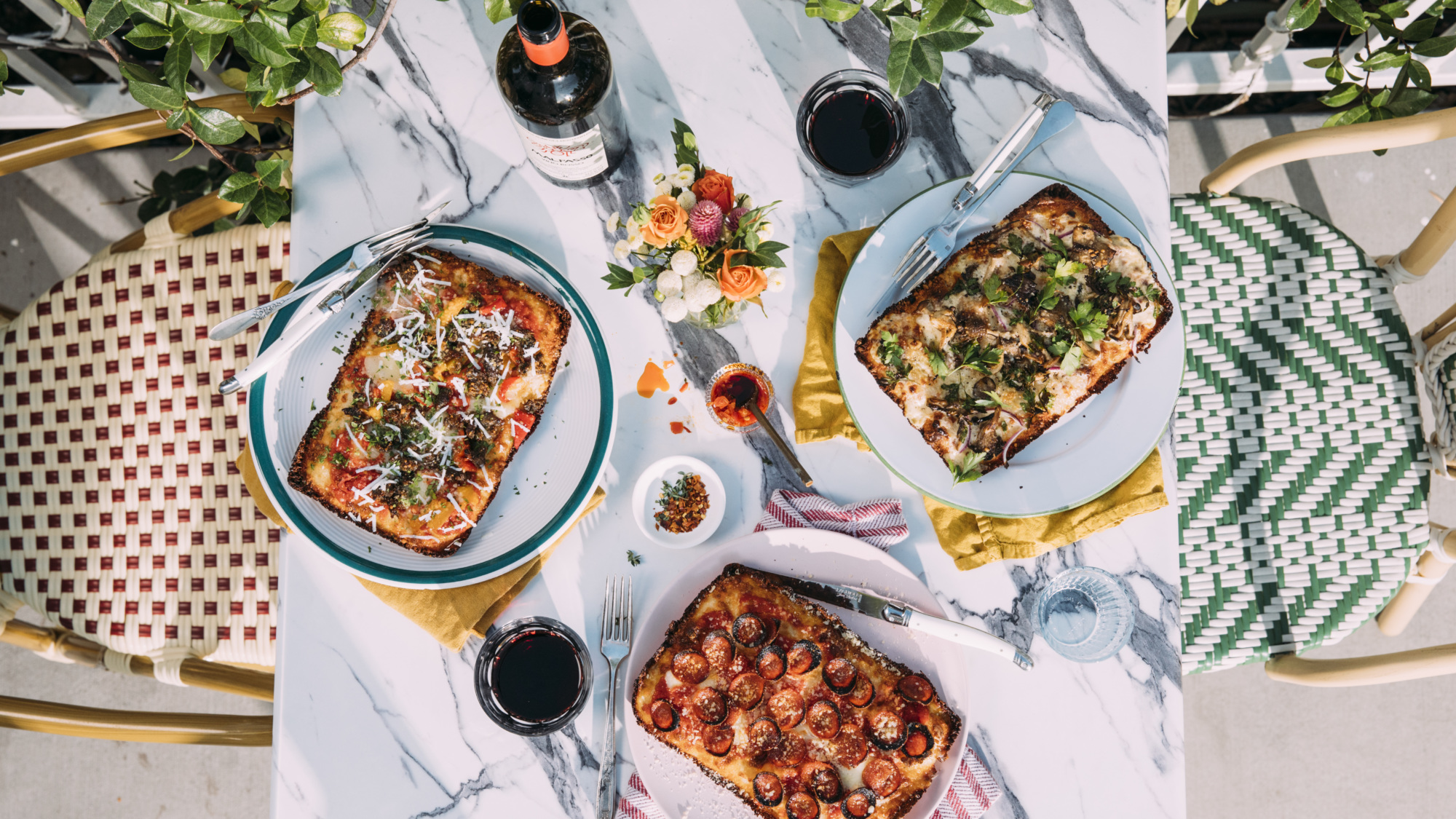
Pizza in Los Angeles Today Is The Best Ever. It’s Also … Complicated.
Los Angeles is not known for its pizza. Historically, that is. Slice shops don’t exist on every corner like they do in New York. There are not two beloved styles of pizza vying for attention, like Chicago’s deep dish and tavern-style thin-crust. Compared to the legendary New Haven pizzerias Frank Pepe’s (1925) and Sally’s Apizza (1938), L.A.’s most famous pizza joint opened in 2006.
“L.A. doesn’t have this century-old pizza-making tradition that the entire nation is fixated on,” says Aaron Lindell, the pizzaiolo behind Quarter Sheets in Echo Park. But the relative lack of pizza history isn’t a bad thing. In fact, it’s a major part of what draws people to making pizza in L.A.: since pizzaiolos aren’t competing to make the best version of a specific style, they’re instead free to chart their own course.
Unrestricted by regional tradition or rigid technique, there is a thrilling boundlessness to the pizza landscape in Los Angeles. What it lacks in methodical definition, it makes up for with other core tenets, including a respect for seasonal cooking and a wealth of multicultural inspiration.
Thanks to the steady stream of bakers and chefs gracing us with delicious pies and a recent influx of pandemic-born pizzerias, L.A. today is home to a rich pizza scene that fuses styles, spotlights market produce, and prioritizes personal expression. Angelenos can enjoy Roman pizzas in a glitzy Hollywood dining room, wood-fired pies in a laid-back Altadena garden, sourdough crusts topped with seasonal ferments, slices laden with mole and Oaxacan cheese, and French dip calzones, among others.
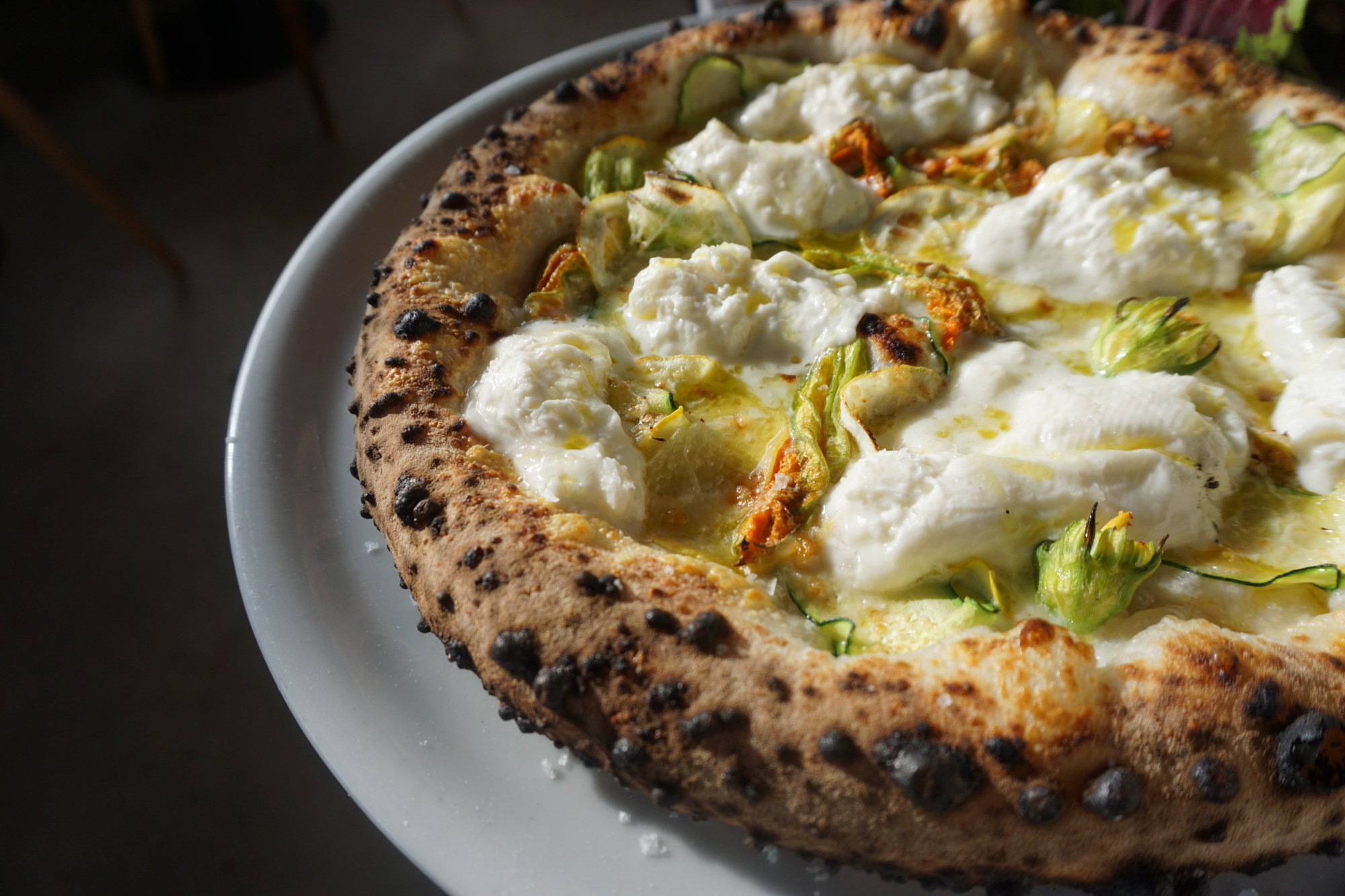

Is there such a thing as L.A.-style pizza, though? If you ask the pizza-makers who are putting out some of the city’s most compelling pies, the answer is somewhat bashful, oftentimes rambling, but decidedly yes. Some say L.A.-style pizza is defined by its proximity to high-quality ingredients. Others say that the city’s diverse blend of cuisines is reflected in its pies.
Nancy Silverton, whose Pizzeria Mozza is famous for its flavorful crusts and farm-fresh toppings, says, “I feel the term means fresh, seasonal, and non-traditional ingredients.” In an email, she credits the late Ed LaDou, “who really created the pizzas at Spago and later his own Laurel Canyon restaurant Caioti,” for what she considers to be L.A.-style pizza. (LaDou is also responsible for developing California Pizza Kitchen’s first menu — including its barbecue chicken pizza.)
For Lindell’s rendition of L.A.-style pizza, he fuses the cheesy, crispy-edged square pies of his childhood near Detroit with the upside-down Sicilian way of building a pizza (cheese first). The other defining qualities of a Quarter Sheets slice are its fried dough underside and a chewy, bubbly interior that resembles a rustic loaf of sourdough. Lindell and his partner, the pastry chef Hannah Ziskin, worked for many years in the Bay Area before moving to L.A., where they started their pizza and cake restaurant as a pop-up in 2020. “Coming from the Midwest by way of San Francisco, I feel free to do pretty much whatever I want,” he says.
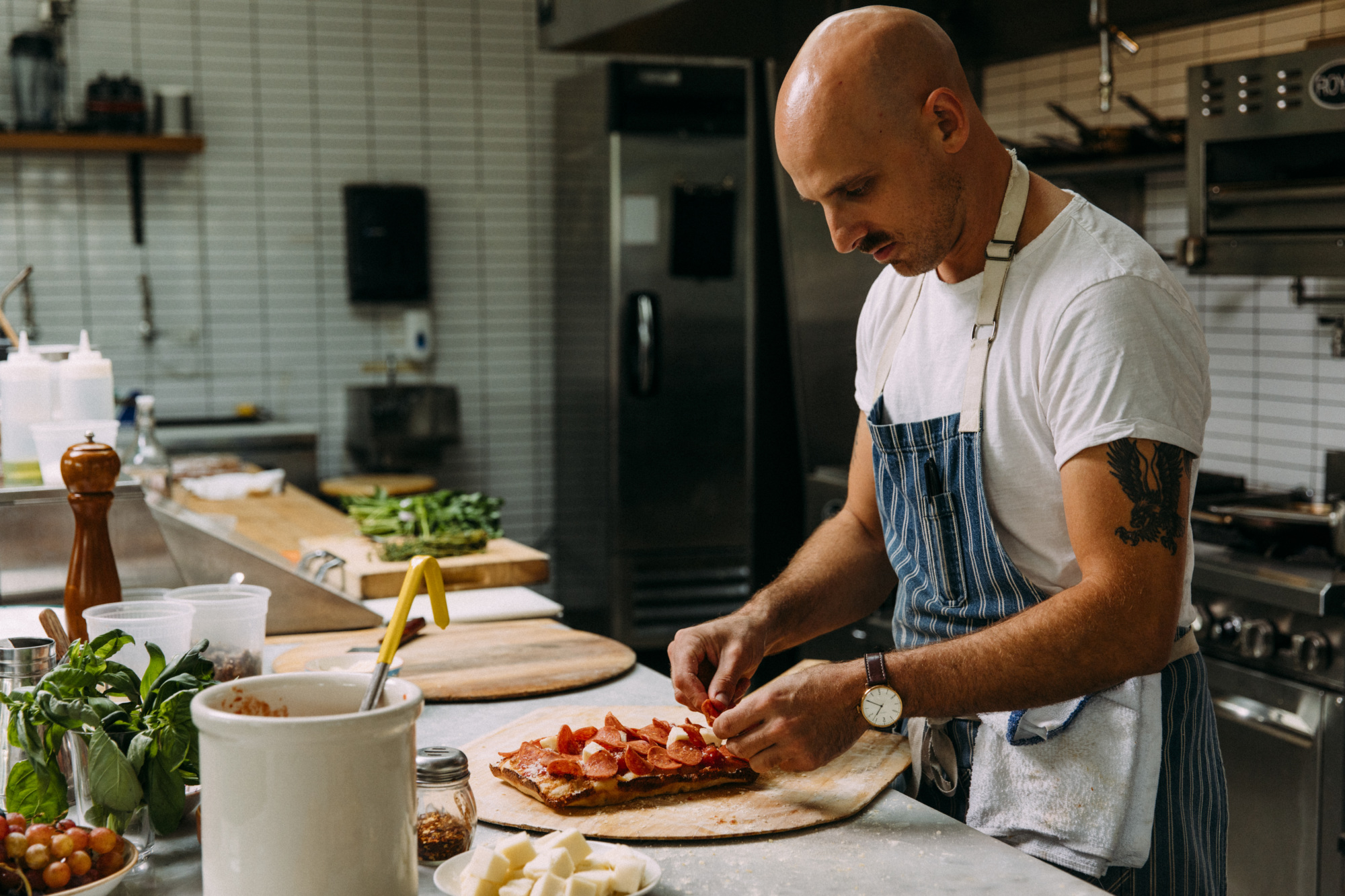

Patrick Costa, the chef of De La Nonna — another pandemic pop-up turned brick-and-mortar pizzeria — would agree. Like Lindell, he utilizes a Detroit-style frico crust on his square pies, but also borrows from Roman and grandma styles to create his own distinct pizza. “I just took the pieces that I liked from different styles and tried to combine them as best as possible,” he says. “I think that’s something unique here. If you’re going to a pizzeria in New York, it better have damned good New York-style pizza, but here we’re able to have a little more fun.”
One way to think about L.A.-style pizza is as a subcategory of what we now call California cuisine. The farmers market is a regular source of inspiration for pizza-makers. As the fine dining chef-turned-pizzaiolo Brandon Gray puts it, “Because we have amazing produce year-round, why not use what’s in season? Not everybody has that luxury.” At his take-out-only pizzeria Brandoni Pepperoni, Gray makes Neapolitan-style pizzas (with heartier doughs inspired by his childhood love for Pizza Hut) that highlight the farmers he’s built relationships with while working at restaurants like Providence and Trois Mec. One of his current pizzas — a vegan number called Steady Mobbin’ — features roasted broccolini and arugula pesto, both sourced from Coleman Farms, and an assortment of basil from Wong Farms. At De La Nonna, Costa always runs one or two “market” pizzas. Currently, it’s charred spring onion and snap peas with mint and chile pepper.
Hand-in-hand with the emphasis on seasonal produce, California cuisine also relies on local and sustainable sourcing, even for ingredients often considered pantry staples. Several of the pizzaiolos in this story use flour from the Tehachapi Heritage Grain Project, a local source for organic heritage grains. Almost all of them use canned Bianco DiNapoli or Alta Cucina tomatoes for their tomato sauce, both of which are grown in-state.
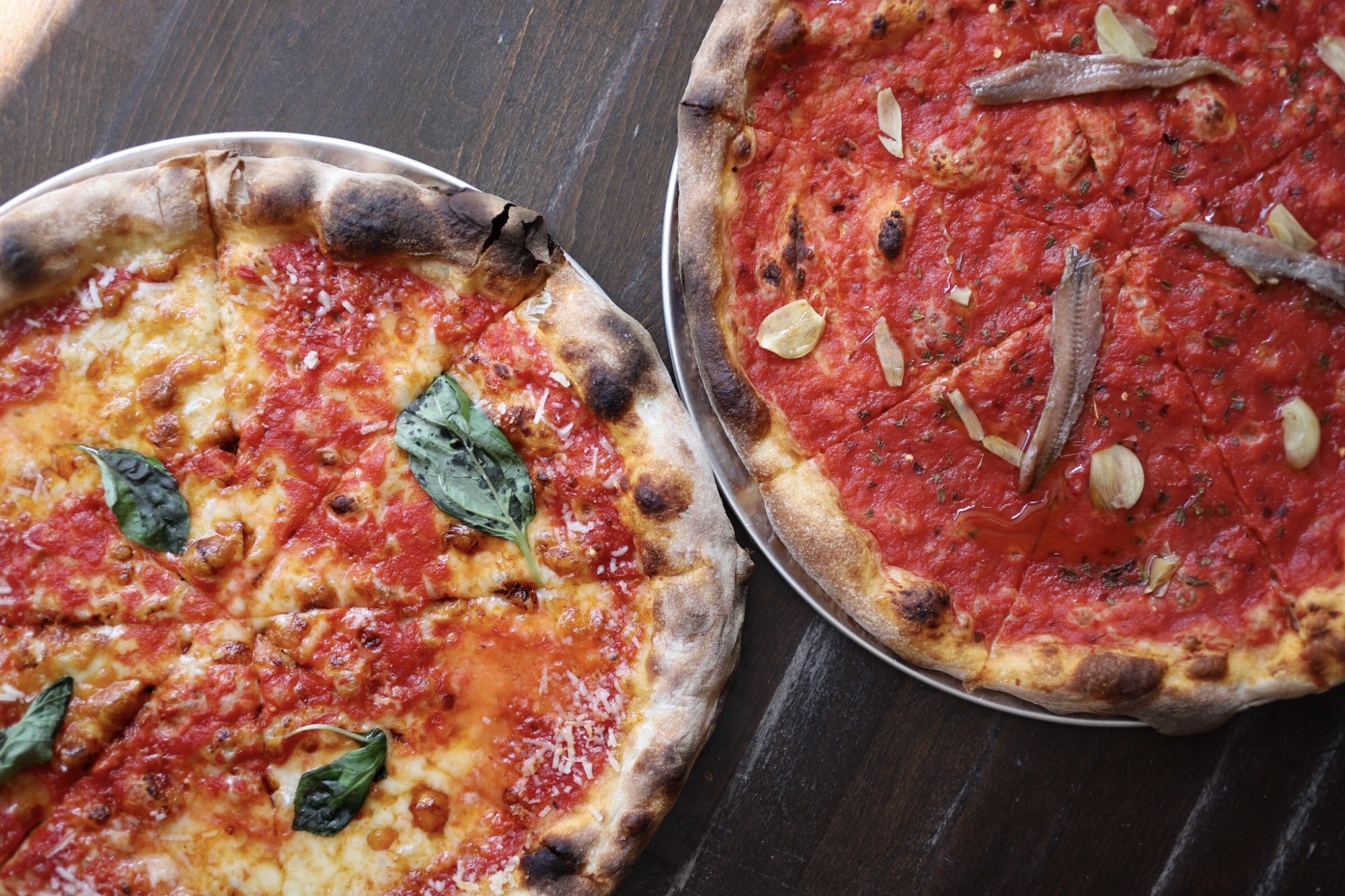
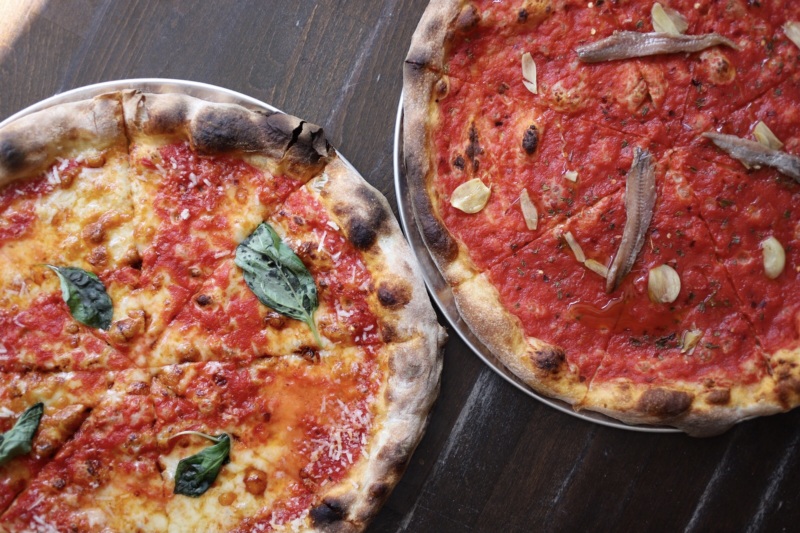
At U Street in Pasadena, there’s a “Petaluma Style” pie that features mozzarella from Sonoma-based Petaluma Creamery, topped with a cooked grandma-style sauce made with Bianco DiNapoli tomatoes and a generous dusting of pecorino romano. Chef Christopher Keyser describes it as “an homage to California.” The rest of his cracker-crust pies are finished with Fiscalini cheddar from Modesto, which mimics the flavor of a more traditional Italian Parmesan. “It’s aged like Parm so it has the crystals, but it’s not as aggressive or salty — it’s a little bit more complex, and honestly, I like it better on pizza,” he says. Keyser’s goal at U Street is to combine the New York-style pizza of his childhood with what the California market has to offer. “All of these ingredients that I work with, I really believe in, I’m passionate about, and I want to showcase,” he says.
Pizza chefs here also draw inspiration from the incredible diversity of cuisines across the city. Gray offers an Oaxaca-inspired pizza called “Californication,” with steamed lamb shoulder, Oaxacan cheese, Kandarian Farms’ chickpeas, pickled red onions from Milliken Farms, and salsa borracha. Lindell often runs a pineapple pizza special at Quarter Sheets with pepperoni, pickled jalapeño, and sambal goreng made by their friends at Bungkus Bagus, a Balinese street food stand at Smorgasburg. Costa says the inspiration for the mountain of herbs atop his mushroom pizza comes from his time in Vietnam and the large Vietnamese population around Southern California. “I’m pulling from not just from different types of pizza, but different types of cuisine as well,” he says.
When Ines Barlerin Glaser of Lupa Cotta first started popping up at bars with balls of dough and her 40-pound Gozney Roccbox, her menu was streamlined. She would offer a neo-Neapolitan style margherita, a pepperoni with hot honey, and a third, “adventurous” pizza. “It was a mixture of whatever was available at the farmers market and what was influencing me at the moment from different cultures,” she recalls. That knack for fusion has also inspired a collaboration series with other chefs. For the month of February, Glaser focused on making salad pizzas, and devoted her Instagram to showcasing creations like a fishcake and pickled cucumber salad pizza with the Vietnamese-Australian chef Sandy Ho and a fattoush-topped pie with artist Zoë Komarin. She feels that working within the L.A. style has granted her the freedom to innovate and meld. “We’re starting a new-age pizza revolution, creating some really awesome and beautiful new things that wouldn’t be allowed in other places,” she says.
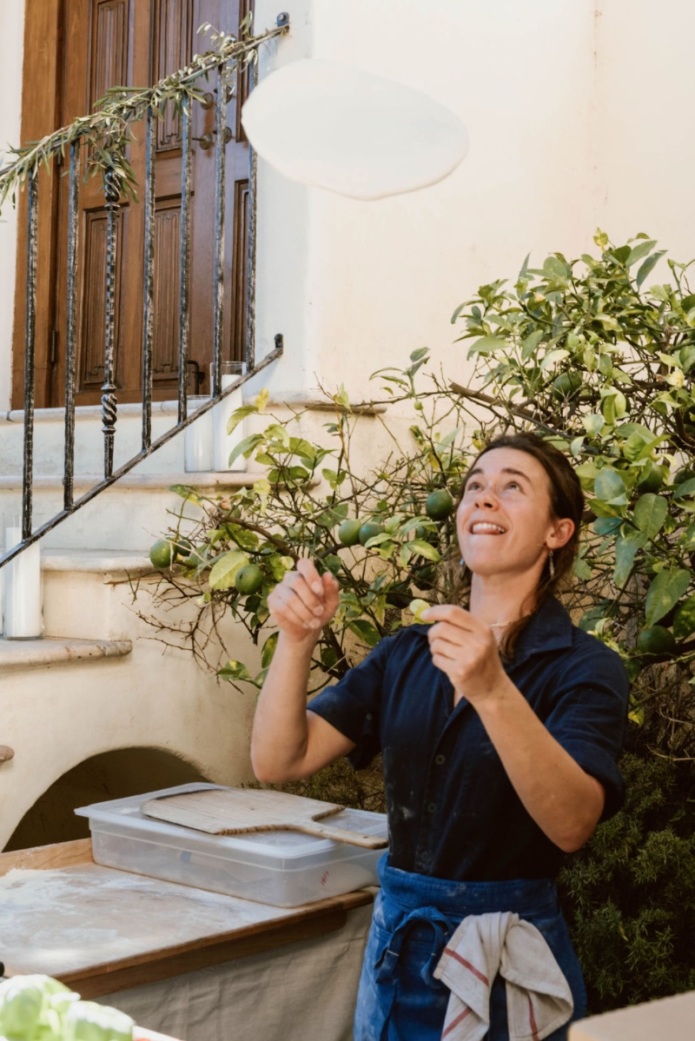
Chef Daniel Cutler of the popular West Hollywood pizzeria Ronan argues that since L.A.’s food scene is already a glorious mish-mash of cuisines, the same naturally holds true for the city’s pizza. “Everybody is here. Every culture is doing everything. There are Korean people doing Mexican food, American people doing Japanese food, everything is so entangled,” he says. In other words, although he is, you don’t have to be from L.A. to make L.A.-style pizza. “So many different people are making it. There are formal pizza restaurants, there are casual pizza restaurants, there are pop-ups that are insanely popular right now. There are people using sourdough, people doing Roman-style, Neapolitan-style, or just their own style,” he says. Cutler’s pizzas are made of 100% sourdough and wood-fired to produce puffy, blistery crusts. While the classics — margherita and pepperoni — remain his bestsellers, his favorite pizza of his own is a white pie that reimagines Buffalo wings with ‘nduja, gorgonzola crema, green onion, and celery.
The pizza scene in L.A. doesn’t just permit personal expression, it practically demands it. “It’s not like you’re going from slice joint to slice joint. You’re going from this person’s pizza to this person’s pizza,” Cutler says. From Lupa Cotta’s collaborative pies topped with nontraditional ingredients to Gray naming pizzas after West Coast hip-hop songs, pizzaiolos here are doing their own thing, and proudly so. When I asked Silverton, another L.A. native, what makes the pizza at Pizzeria Mozza unique, she answered, “I can only guess it’s that I make it the way I want to, and not to copy anyone else.”
Emily Wilson is a Los Angeles-based food writer from New York. She has contributed to Bon Appétit, Eater, TASTE, The Los Angeles Times, Punch, Atlas Obscura, and more. Follow her on Twitter and Instagram. Follow Resy, too.















